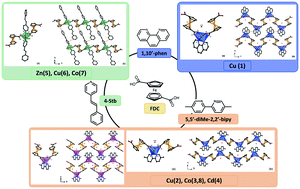Self-assembly and supramolecular isomerism in 1D metal–organometallic networks based on transition-metal assemblies from 1,1′-ferrocene-dicarboxylic acid and ancillary nitrogen heterocycle ligands†
Abstract
A series of eight novel 1D metal–organometallic networks of Cu(II)/Co(II)/Cd(II) and Zn(II) bearing the bidentate ligands 1,10′-phenanthroline (1,10′-phen) and 5,5′-dimethyl-2,2′-bipyridine (5,5′-diMe-2,2′-bipy) and terminal ligand 4-stilbazole (4-Stb) were prepared by hydrothermal synthesis and were structurally characterized by using X-ray diffraction techniques. The crystal structures comprise 1D chains built-up from the self-assembly of metal centres, chelating or monodentate nitrogen ligands and bridging 1,1′-ferrocenedicarboxylate anions (Fdc)2−. Despite the fact that such arrangements contain similar building blocks, the resulting 1D arrays display different structural topologies. The major difference in these structures stems from the different conformations of the flexible ferrocenyl dicarboxylate or from the relative orientation of such units in the resulting metal–organometallic networks. The structures of {[Cu(1,10′-phen)(Fdc)]·H2O}n (1), {[Cu(5,5′diMe-2,2′-bipy)(Fdc)]·H2O}n (2), {[Cd(5,5′diMe-2,2′-bipy)(Fdc)(OH2)]}n, (4) and {[Co(5,5′diMe-2,2′-bipy)(Fdc)]·H2O}n (8) have zig-zag-type 1D chains. In contrast, the molecular assembly of {[Co(5,5′diMe-2,2′-bipy)(Fdc)]·1.5H2O}n (3) comprises a 1D-helical chain related by a 21 screw axis. When bidentate ligands are replaced by a terminal ligand, stepped chains are afforded for isomorphous phases of Co(II)/Zn(II)-derivatives: {[Co(4-Stb)2(Fdc)(OH2)]}n (5) and {[Zn(4-Stb)2(Fdc)(OH2)]}n (6), whereas {[Cu(4-Stb)2(Fdc)]}n (7) displays a double chain from bridging dicarboxylate showing a syn–anti coordination mode to adjacent metallic centres. Further characterization by powder X-ray diffraction reveals a concomitant formation of two novel conformational supramolecular isomers in the Co(II)/Fdc/5,5′-diMe-2,2′-bipy system: 3 and 8. Additional characterization was provided by Fourier transform infrared spectroscopy, thermogravimetric analysis, solution-state differential pulse voltammetry, and by calculating the frontier orbitals.

- This article is part of the themed collections: Celebrating Latin American Chemistry and Coordination Networks


 Please wait while we load your content...
Please wait while we load your content...